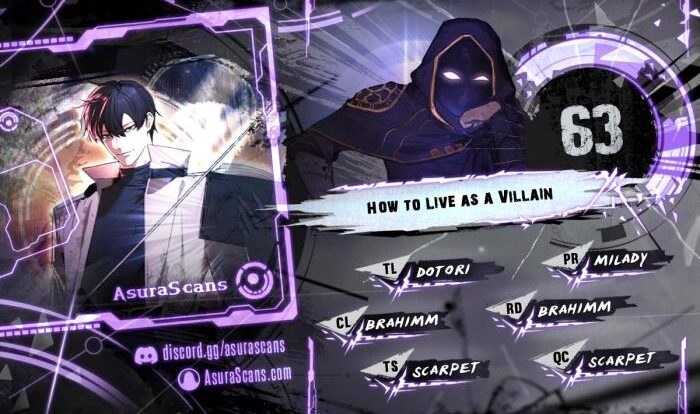
How to live as a villain ch 94 – In the realm of fiction, villains often captivate audiences with their cunning schemes and enigmatic personalities. Chapter 94 of “How to Live as a Villain” delves into the intricacies of crafting a compelling villainous character, providing a comprehensive guide to their strategies, motivations, and potential.
This chapter offers valuable insights into the art of villainy, exploring the key elements that make a villain both formidable and relatable. From developing their lair and hideout to forming alliances and rivalries, the guide equips readers with the knowledge to create a villain who leaves a lasting impression.
Villainous Schemes and Strategies

Villains throughout history have employed a vast array of schemes and strategies to achieve their nefarious goals. These plans vary in their effectiveness, consequences, and risks, making it essential for aspiring villains to carefully consider their choices.
Coercion and Intimidation
- Blackmail:Threatening to expose damaging information unless demands are met. This strategy can be highly effective, but it carries the risk of retaliation or exposure of the villain’s own secrets.
- Extortion:Demanding payment or services under threat of violence or harm. While lucrative, extortion can lead to dangerous confrontations and law enforcement involvement.
- Terrorism:Instilling fear and panic through acts of violence or sabotage. This strategy can be effective in creating chaos and disruption, but it often attracts significant negative attention and backlash.
Character Development for a Villainous Protagonist
A villainous protagonist is a central character in a story who possesses antagonistic qualities and motivations. They are often driven by personal vendettas, a thirst for power, or a twisted sense of justice.Creating a compelling and relatable villainous character requires careful consideration of their key characteristics and traits.
Villains should be intelligent, resourceful, and possess a strong will. They should also have a clear motivation that drives their actions and makes them relatable to the audience.
Developing the Villain’s Motivations
The motivations of a villain are crucial to their character development. They should have a clear goal that drives their actions and makes them relatable to the audience. Common motivations for villains include revenge, power, or a desire to change the world according to their own twisted beliefs.
In the captivating world of “How to Live as a Villain” chapter 94, the protagonist grapples with unforeseen challenges. While seeking guidance on oral health, readers may encounter the informative article How to Cure Gum Disease Without a Dentist . Returning to the thrilling narrative, “How to Live as a Villain” continues to unravel the complexities of the protagonist’s treacherous path.
Crafting the Villain’s Backstory
A villain’s backstory provides insight into their motivations and helps make them more relatable. It should explain how they became a villain and what events shaped their personality. The backstory should be consistent with the villain’s character and motivations, and it should provide a deeper understanding of their actions.
In chapter 94 of “How to Live as a Villain,” the protagonist’s cunning strategies and ruthless tactics are put to the test. The latest chapter offers readers an immersive experience, delving into the complexities of navigating a treacherous world as a villain.
For more information on related topics, visit Allegheny Mecconline , a comprehensive resource for insights into the world of villains and anti-heroes. Chapter 94 of “How to Live as a Villain” continues to captivate readers, leaving them eager for the next installment.
Developing the Villain’s Personality
The personality of a villain is what makes them unique and memorable. They should have a distinct voice, mannerisms, and beliefs that set them apart from other characters. The villain’s personality should be consistent with their motivations and backstory, and it should contribute to the overall narrative of the story.
Crafting a Villainous Lair and Hideout: How To Live As A Villain Ch 94
Designing a villainous lair and hideout is a crucial aspect of establishing a formidable presence and maintaining secrecy. The lair should provide a safe haven for planning schemes, conducting experiments, and storing ill-gotten gains.
The design of the lair should prioritize security measures, including multiple layers of access control, motion sensors, surveillance cameras, and even booby traps to deter intruders. Secret passages and hidden compartments allow for quick escapes or the concealment of sensitive materials.
Blueprint of a Villainous Lair
The blueprint of a villainous lair typically includes several key features:
- Control Room:The central hub for monitoring security systems, communications, and surveillance footage.
- Laboratory:A dedicated space for conducting experiments, developing gadgets, or researching new schemes.
- Armory:A secure storage facility for weapons, gadgets, and other equipment.
- Prison:A secure location for holding captives or interrogating prisoners.
- Escape Routes:Multiple secret passages or hidden exits for quick getaways in case of emergencies.
li> Living Quarters:Private spaces for the villain and any accomplices, including bedrooms, bathrooms, and a kitchen.
Location and Design Considerations, How to live as a villain ch 94
The location and design of the lair play a vital role in its effectiveness. Isolated areas, such as abandoned warehouses or remote mountaintops, provide privacy and reduce the risk of detection. Underground bunkers or underwater bases offer additional protection from external threats.
The design should consider factors such as camouflage, structural integrity, and accessibility. The lair should blend seamlessly with its surroundings or incorporate deceptive elements to avoid suspicion.
Villainous Alliances and Rivalries
Villainous alliances and rivalries are a staple of the villainous landscape. These relationships can be complex and multifaceted, and they can have a significant impact on the success or failure of a villain’s plans.One of the most common types of villainous alliances is the partnership between two or more villains who share a common goal.
These alliances can be based on mutual respect, shared ideology, or simply a desire to pool resources. While alliances can provide villains with a number of benefits, they also come with a number of risks.One of the biggest benefits of forming an alliance is that it can give villains access to resources that they would not otherwise have.
For example, a villain who is skilled in technology might team up with a villain who has access to a large amount of money. This alliance would give the first villain the resources they need to develop new weapons or gadgets, while the second villain would gain access to the first villain’s expertise.Another
As we delve deeper into the thrilling narrative of “How to Live as a Villain” Chapter 94, we stumble upon an intriguing dilemma: how to maintain oral hygiene in the absence of dental care. Fortunately, the internet holds a wealth of knowledge on this subject, such as the comprehensive guide How to Cure Gum Disease Without a Dentist . Armed with this newfound wisdom, we can now return to the captivating tale of “How to Live as a Villain” Chapter 94, where our antihero faces a new set of challenges.
benefit of forming an alliance is that it can provide villains with a sense of security. When villains work together, they can watch each other’s backs and provide support in times of need. This can be especially important for villains who are operating in hostile environments or who are facing threats from other villains.However,
there are also a number of risks associated with forming alliances. One of the biggest risks is that the alliance could fall apart. This could happen for a number of reasons, such as a change in circumstances, a betrayal by one of the members, or simply a disagreement over how to achieve their goals.Another
risk of forming an alliance is that it could lead to conflict with other villains. If two alliances of villains are competing for the same resources or territory, it could lead to a war between the two groups. This could be costly and dangerous for both sides, and it could ultimately lead to the downfall of one or both alliances.Despite
the risks, villainous alliances can be a powerful tool for villains who are looking to achieve their goals. However, it is important to carefully consider the pros and cons of forming an alliance before making a decision.
Rivalries
Rivalries between villains are also a common occurrence. These rivalries can be based on personal grudges, conflicting goals, or simply a desire to prove who is the better villain. Rivalries can be a source of motivation for villains, and they can also lead to some of the most exciting and memorable moments in villainous history.One
of the most famous villainous rivalries is the rivalry between the Joker and Batman. The Joker is a psychopathic criminal who enjoys chaos and mayhem, while Batman is a vigilante who is dedicated to protecting the innocent. The two characters have been locked in a deadly game of cat and mouse for decades, and their rivalry has produced some of the most iconic moments in comic book history.Another
For those who are curious about the next chapter of the popular webtoon “How to Live as a Villain,” chapter 94 is now available for reading. In other news, those who are experiencing gum disease may be interested in exploring alternative treatments.
While visiting a dentist is typically the recommended course of action, there are certain home remedies and natural approaches that may provide relief. Click here to learn more about how to cure gum disease without a dentist. Returning to the topic of “How to Live as a Villain,” chapter 94 delves deeper into the protagonist’s journey and offers some unexpected twists and turns.
famous villainous rivalry is the rivalry between Lex Luthor and Superman. Luthor is a brilliant scientist and businessman who is obsessed with destroying Superman. Superman is a powerful alien who is dedicated to protecting the Earth. The two characters have been locked in a battle of wits and strength for decades, and their rivalry has produced some of the most memorable moments in superhero history.Villainous
rivalries can be a source of great entertainment for fans of the genre. However, it is important to remember that these rivalries are often based on violence and conflict. It is important to be aware of the potential dangers of villainous rivalries, and to avoid glorifying or romanticizing them.
The Villain’s Nemesis and Hero Antagonist
The villain’s nemesis is a formidable adversary who poses a significant threat to their plans. They are often a hero or a law enforcement official with a strong moral compass and a determination to bring the villain to justice. The nemesis’s strengths lie in their unwavering belief in justice, their strategic thinking, and their ability to rally support from others.
However, they may also be limited by their adherence to rules and their unwillingness to resort to underhanded tactics.The hero antagonist, on the other hand, is a complex character who may have noble intentions but employs questionable methods to achieve their goals.
How to Live as a Villain ch 94 offers a unique perspective on the morality of villains, while how to cure gum disease without a dentist provides practical advice for maintaining oral health. Despite their contrasting themes, both topics explore the importance of personal agency and responsibility, as well as the consequences of one’s actions.
They may be driven by a desire for revenge, a thirst for power, or a misguided belief that they are acting for the greater good. The hero antagonist’s strengths include their charisma, their ability to manipulate others, and their willingness to take risks.
However, they may also be vulnerable to corruption, self-righteousness, and a lack of empathy.
Potential for Redemption or Transformation
The potential for redemption or transformation for the villainous character depends on several factors, including the severity of their crimes, their motivations, and their willingness to change. Some villains may be irredeemable, having committed heinous acts that cannot be forgiven.
Others may be capable of redemption if they genuinely regret their actions and are willing to make amends. The path to redemption is often difficult and requires the villain to confront their past mistakes, make amends to those they have wronged, and adopt a new way of life.
Final Wrap-Up
Chapter 94 of “How to Live as a Villain” serves as a valuable resource for aspiring writers and enthusiasts alike. It provides a structured approach to understanding the complexities of villainous characters, empowering readers to create compelling antagonists who drive the narrative forward and captivate audiences.
FAQ
What is the significance of the villain’s lair in the story?
The villain’s lair serves as their sanctuary and base of operations. It reflects their personality and provides a glimpse into their motivations and goals.
How can a villain be both formidable and relatable?
A compelling villain possesses a combination of strength, cunning, and vulnerability. They have clear motivations and a backstory that makes their actions understandable, even if not justified.
What are the potential consequences of forming alliances with other villains?
While alliances can provide benefits, they also carry risks. Betrayal, conflict, and power struggles can arise within villainous organizations.





